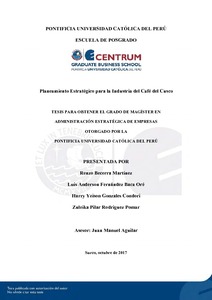Planeamiento estratégico para la industria del café del Cusco

View/
Date
2017-11-03Author
Becerra Martínez, Renzo
Fernández Baca Oré, Luis Anderson
Gonzales Condori, Harry Yeison
Rodriguez Pomar, Zuleika Pilar
Metadata
Show full item recordAbstract
En el presente trabajo titulado Planeamiento Estratégico para la Industria del Café del
Cusco 2017-2027, se han analizado los aspectos internos y externos que rigen la industria
cafetalera de ese departamento y se han establecido un grupo de estrategias que tiene como
objetivo que Cusco se convierta, en 2027, en el primer comercializador de café convencional
del Perú con US$250 millones de facturación y una utilidad bruta de US$100 millones, lo que
generará 55 mil empleos directos.
El café cusqueño facturó US$6.7 millones en 2016 y es el quinto productor en el Perú
con 58,098 has cosechadas. El producto muestra una gran potencialidad para su desarrollo
gracias a la calidad de su grano y las condiciones geográficas y climáticas en que se cultiva;
sin embargo, los cafetaleros cusqueños han enfrentado fuertes problemas que han limitado su
desarrollo productivo como plagas que afectaron los cultivos, falta de asistencia técnica, bajo
acceso al financiamiento, asociaciones con poca representatividad y mínima incursión en los
mercados potenciales, entre otros.
Para lograr el crecimiento de la industria cafetalera cusqueña se han establecido una
serie de estrategias que permitirá encontrar nuevos nichos e incrementar su participación en
los mercados de exportación tradicionales, así como en el mercado local. Para ello se deberá
mejorar la calidad del café usando estándares internacionales y sellos de garantía, además de
invertir en investigación, capacitación y maquinaría moderna. Esa inversión solo puede ser
posible si se multiplican y se suavizan las posibilidades de financiamiento para los
caficultores cusqueños. Por último, se considera crear alianzas estratégicas entre los
productores cafetaleros para establecer organizaciones sólidas y con poder de negociación
frente a los proveedores y consumidores On the current thesis, titled, Strategic Planning on the Cusco’s Coffee industry 2017-
2027, the internal and external aspects that rule the coffee industry of the region has been
analyzed and a group of strategies that carry the purpose of turning Cusco in 2027, in the first
Peruvian conventional coffee market with invoicing of US $250 million and a net profit of US
$100 million, which will generate 55 thousand direct jobs.
Cusco’s Coffee invoiced US $6 million in 2016 and is considered the fifth higher
producer in Peru with 58,098 ha harvested. The product has great potential for development
thanks to the quality of its grain and the favorable geographical and weather conditions in
which is sawn; although, the coffee growers in Cusco have faced great challenges which have
limited its productivity, such as plagues that have affected the crop, lack of technical support,
low access to financing, associations with little representation and minimal incursion into
potential markets, among others.
To achieve the growth of the coffee industry in Cusco, a series of strategies have been
established that will allow finding new niches and increasing their participation in the
traditional export markets, as well as the local market. Therefore, the quality of the coffee
must get better by using international standards and quality assurance, o top of investigation
investment, training and modern equipment. The investment can only be possible if financing
capabilities are more accessible for Cusco’s growers. Lastly, it is considered necessary to
create estrategic alliances among coffee producers, thus establishing solid organizations with
the power of negotiaition in front of provider and consumers
Temas
Café -- Industria y comercio -- Perú -- Cusco
Planificación estratégica
Planificación estratégica
Para optar el título de
Maestro en Administración Estratégica de Empresas
Collections
The following license files are associated with this item:





